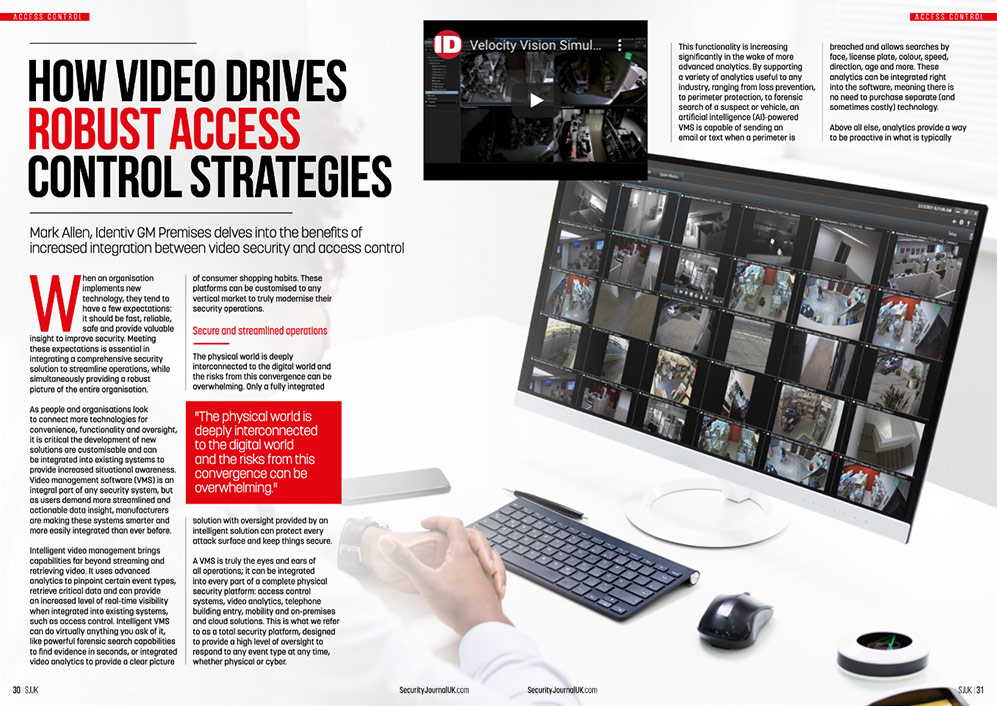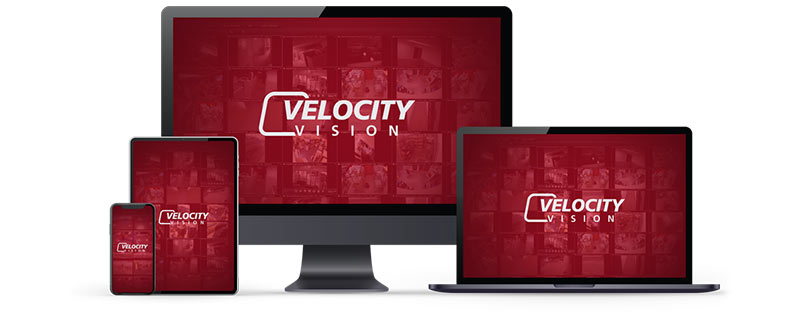Security Journal United Kingdom: How Video Drives Robust Access Control Strategies
June 30, 2021
By Mark Allen, Identiv GM Premises
 This article
This article was originally published by
Security Journal United Kingdom (pp. 30 – 33).
When an organization implements new technology, they tend to have a few expectations: it should be fast, reliable, safe, and provide valuable insight to improve security. Meeting these expectations is essential in integrating a comprehensive security solution to streamline operations, while simultaneously providing a robust picture of the entire organization.
As people and organizations look to connect more technologies for convenience, functionality, and oversight, it is critical the development of new solutions are customizable and can be integrated into existing systems to provide increased situational awareness. Video management software (VMS) is an integral part of any security system, but as users demand more streamlined and actionable data insight, manufacturers are making these systems smarter and more easily integrated than ever before.
Intelligent video management brings capabilities far beyond streaming and retrieving video. It uses advanced analytics to pinpoint certain event types, retrieve critical data, and can provide an increased level of real-time visibility when integrated into existing systems, such as access control. Intelligent VMS can do virtually anything you ask of it, like powerful forensic search capabilities to find evidence in seconds, or integrated video analytics to provide a clear picture of consumer shopping habits. These platforms can be customized to any vertical market to truly modernize their security operations.
Secure and Streamlined Operations
The physical world is deeply interconnected to the digital world, and the risks from this convergence can be overwhelming. Only a fully integrated solution with oversight provided by an intelligent solution can protect every attack surface and keep things secure.
A VMS is truly the eyes and ears of all operations; it can be integrated into every part of a complete physical security platform: access control systems, video analytics, telephone building entry, mobility, and on-premises and cloud solutions. This is what we refer to as a total security platform, designed to provide a high level of oversight to respond to any event type at any time, whether physical or cyber.
This functionality is increasing significantly in the wake of more advanced analytics. By supporting a variety of analytics useful to any industry, ranging from loss prevention, to perimeter protection, to forensic search of a suspect or vehicle, an artificial intelligence (AI)-powered VMS is capable of sending an email or text when a perimeter is breached and allows searches by face, license plate, color, speed, direction, age, and more. These analytics can be integrated right into the software, meaning there is no need to purchase separate (and sometimes costly) technology.
Above all else, analytics provide a way to be proactive in what is typically a reactive environment. Without analytics, it is difficult to pinpoint where a suspect is, what they have stolen, or to which unauthorized entry point they have gained access. Analytics alert users the moment there is a breach, providing the opportunity to respond as quickly as possible.
Of course, analytics cannot fully prevent events from occurring, but they can assist us in pinpointing what happened, how it happened, and in turn, users can create a plan of attack that makes sense for any given situation. This technology matured greatly in the past decade, and is now an integral part of VMS platforms.
Video and Access Control: Building Intelligence
Information is power. The Internet of Things (IoT) and advancing technologies bring opportunities to increase productivity and optimize operations through greater connectivity and information sharing. The prevalence of interconnected devices means businesses have access to more data than ever before. Leaders need to find efficient ways to extract the right information and make the best business decisions to keep operations running at optimal levels.
The more information you have, the better you can run your security program. But you need a method to comb through the access control data. AI and video analytics can help by providing metadata. In security applications, standard analytics tools help you identify metadata associated with motion, color, facial, license plate recognition, access granted, access denied, people count, and dwell time.
Although access control may not seem to benefit as much from an analytic layer as video surveillance, the opposite is true. Any event coming from an access control system could — and should — be viewed as potential analytics metadata to a VMS. Conversely, an image of a person coming through an entry point (and identified through the system as an alert) is metadata a VMS can communicate to an access control system. For example, what if a person jumped a subway turn-style without scanning a metro pass? This is an event analytic the access control system can use to see how many people presented a valid subway pass versus the number who did not.
This is how metadata events can provide value in both systems. We must also consider what types of VMS events can be used with access control systems. Here are some use cases:
Tailgating: People counting tied to a VMS shows two people going through a door in rapid succession, but the physical access control system (PACS) only shows a single access grant. This is called tailgating. The access control system receives this event from the VMS, which the PACS system records as a possible tailgating event, and compares it to its access grant system. If there was only a single access grant, it can flag it or alert an administrator, who can then forensically use both systems to see who the first entrant was, and perhaps also who tailgated, and then take appropriate steps.
Lockdowns: In the shadow of COVID-19, one might use occupancy data from a VMS to trigger a lockdown of an area, and not permit new entrants until the occupancy drops below a certain threshold. This could be used for classrooms, stores with electric doors, subway platforms, hospitals, and other environments looking to control access levels.
Access control verification: The PACS registers an access grant, and requests an image from the camera pointed at that door from the VMS at a specific time. The access control system logs all of this so audits can be performed to make sure the person with the credential is the person who should have the credential. This could also be used with facial recognition by a VMS to compare the person’s employee photo with the image captured by the VMS to analyze the likelihood it is the same person, and then alert if there is a suspicion it is not.
Access denied logging: The PACS denies access, and requests an image of the event from the VMS. This would allow the PACS to log images of all access denied, and would allow the VMS to do a search for all video images or clips associated with access denied events coming from the PACS system.
Video, analytics, and access control are great security solutions independently, but are even more effective when combined to enhance monitoring. Over the coming years, we can expect to see an uptick in use cases that emerge from combining these two systems together. Not only are access control solutions fully integrated with today’s video management systems to provide full situational awareness, but the trend is growing toward integration with human resources departments and IT data. As we move forward, the new uses will be defined by the organizations that use them most: the end-user.

Unified and Open
Intelligence is only one part of the equation. Video and access control solutions must also be open, allowing ease of integration with other solutions when needed. By empowering a user to select solutions best meeting their specific needs, stakeholders gain access to enhanced video surveillance capabilities and a unified security management system. A true open platform is built to empower stronger security deployments.
At Identiv, our mission is to not only verify your world but make it easier for you to do so. We have built open, scalable, and flexible solutions to make it easier to deploy and manage an integrated system. For example, our Velocity Vision VMS scales up to 1,000s of devices and supports more than 8,500 different camera models at the API level. Beyond API, it integrates seamlessly with more than 15,000 ONVIF-compliant cameras and with technologies from more than 100 ecosystem partners providing the latest capabilities in AI, GPS, access control, and building management. A software development kit (SDK) is also available for complete customization to address specific organizational or industry requirements.
For us, the benefits of being open outweigh the potential negatives. By providing our customers and partners with an inherently scalable security management platform delivering total situational awareness, security leaders engage in faster response, comprehensive case management, and solid compliance. Organizations can integrate with existing investments, oversee operations with complete visibility in real time, and increase the efficiency of investigations and optimize processes. It offers the ability to leverage all types of platforms: on-premises, cloud, hybrid, and mobile. With open, intelligent solutions, security operators can make smarter decisions because they can see, record, and react to environments and access better data.
As a manufacturer, it is our commitment to enable you to achieve the highest levels of security with easy-to-use and manage systems. Technologies only best serve customers if they are easy to buy, install, and manage. The convergence of physical security and IT, and the demand for more data, altered the way people and businesses connect and collaborate. As the growth in network connectivity and web-enabled devices increases, so does the need for greater security of physical assets, networks, and valuable corporate data. We are here to help you navigate the path.